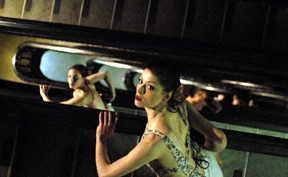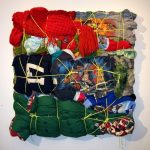The Business of Art: Out of the Studio, Into the Street
Noémie LaFrance. Photo from the dance performance Descent (2002). City Court Building Clock Tower New York, NY. (Photo: Richard Termine). Sens Productions © 2004.
Pioneered in the 1960s by dancers such as Tricia Brown, site-specific dance has become prevalent and increasingly inventive over the past several years. Choreographers like Noémie LaFrance and performers such as Tamar Rogoff are performing inventive pieces in the streets of New York City, confronting the public and mixing rigidly choreographed dance with the spontaneities and idiosyncrasies of the city.
A woman in a fur coat stands in a dark corner peering out at passersby. A man wearing a trench coat and fedora walks past. His head is tilted downward, his gait is brisk, his glances furtive. Audience members settle into the parked cars that line the floor of this Lower East Side Municipal Parking Garage and prepare for Noémie LaFrance’s latest site-specific work, Noir. As dancers scurry past the cars, the clatter of their high heels echoing through the hollow space, or as couples emerge from the darkness to perform sinuous duets filled with intricate weight shifts, viewers, including this dance viewer, take part in the voyeuristic thrill of watching-through windshields, side and rear windows, and even neighboring car windows. From these various vantage points, with the window frames fittingly serving as a kind of film screen, LaFrance’s homage to American film noir of the 1940s unfolds.
While the choreography’s focus on partnering sequences, designed to invoke the tensions and dangers inherent to film noir classics like Mildred Pierce or Double Indemnity, is impressive if a little repetitive, it’s the actual site of the piece-a parking garage-that takes center stage. Dimly lit, cavernous, industrial, cold, and gray, this otherwise ubiquitous public space is transformed into an ominous, eerie backdrop for a dance play filled with intrigue, danger, and betrayal. Rather than simply having dancers’ movements paint the blank canvas that is the proscenium stage, site-specific works like Noir place dance in unlikely spaces so that the work becomes just as much about place, or site, as it is about bodies and how they move through those sites.
Along with LaFrance, whose previous site-specific works include Descent—the Bessie-award winning 2002 dance down a 12-story clock tower in Lower Manhattan—there are several other choreographers working in this vein. Julia Mandle, for one, has been bridging choreography, costume design, and urban design in works like Feast, a 2002 performance in an old police horse stable in Brooklyn’s DUMBO neighborhood, and Fox Square, where dancers wearing Mandle’s signature geometric costumes performed choreographer Mark Jarecke’s idiosyncratic movements in the middle of a forgotten square that was once the center of downtown Brooklyn’s old theater district. Even more recently, the Lower Manhattan Cultural Council in collaboration with the Dancing in the Streets organization is currently presenting SiteLines, a site-specific dance series. Among the performances were Heather Harrington’s Giscard Games in which dancers moved up and down the steps of Federal Hall, across the street from the New York Stock Exchange, reflecting the capricious nature of capitalism. In Night for Day, also part of SiteLines, Tamar Rogoff will drag a bed through part of lower Manhattan several times from August 8-12, evoking the delicate work/life balance that plagues this overworked, sleep-deprived capital of the world.
What is it about site-specific dance that makes it so alluring for both choreographers and spectators? For seasoned and neophyte audiences it may be that the immediacy of live performance in an everyday space re-contextualizes the dancers’ movements and actions, allowing time for the discovery of an unexpected beauty of utilitarian spaces. Site-specific works—particularly those that take place on sidewalks, in parks, or on the steps of businesses—blur the boundaries between performance and everyday living, explicitly revealing the constant flow of activity that takes place amidst the urban landscape. Conceivably, a link could even be made between the proliferation of site-specific dance and the current cultural phenomenon of all things “reality,” from television shows to independent documentary film. Live performance—reality at its most immediate and ephemeral—placed in unexpected situations that leave space for spontaneity adds yet another layer of the “real” to this quest for the ultimate, authentic experience. From a choreographer’s perspective, choosing one’s own performance site not only offers new artistic and aesthetic possibilities, but also sidesteps the frustrating and laborious climb through bureaucratic dance-presenting venues.
Site-specific dance isn’t a brand new phenomenon. Postmodern dance of the ‘60s and ’70s looked to everyday movements like running and walking to transform and redefine the language of dance, and in so doing began to situate dance in spaces of the everyday. But contemporary site-specific works have begun to move beyond the novelty factor of dance in new spaces, and are often highly interdisciplinary and theme-based. Noir, for instance, bridges film, urban studies, architecture, and dance, while distilling the essence and ambiance of the crime film. In addition, LaFrance’s Descent merged architecture, history, and dance, evoking the private lives of women who bathed, cooked, and cleaned behind the closed doors of Lower East Side tenement apartments.
Mandle’s Feast, a loose retelling of Plato’sSymposium, was part art installation, part dance, and it forced audience members to interact with the performance, moving up and down a series of bleachers, in a quasi-study of crowd psychology. In Fox Square, Mandle collaborated with Jarecke, a choreographer, and architect Ariel Krasnow. Works like this-dance performances that transcend the dance community—open up dance and emerging choreographers’ works to new audiences. At any one time they can touch the circles of community members, public officials, developers, urban planners, and policy makers.
Site-specific work is, in the end, a performance, and performance at its most basic is ritual. The traditional performance experience, with its gradually filling seats, footlights, and murmur and hush of an audience, is magical. Taking performance, especially dance, and placing it outside the theater and into nontraditional performance spaces adds a new effect to the spectacle—one that feels more primitive, more pagan, and even more ritualistic. Perhaps this is because site-specific dance celebrates our public spaces—areas that are increasingly monitored—and reminds us of not only the city we live in, but our places in that city. Whether it takes place in a stairwell, parking garage, on a rooftop, or across a plaza, site-specific dance tells us stories about our lives, while simultaneously permeating reality and telling stories born in the very sites in which our lives take place.
Vanessa Manko writes about dance and lives in Brooklyn. She is the dance editor of the Brooklyn Rail.





